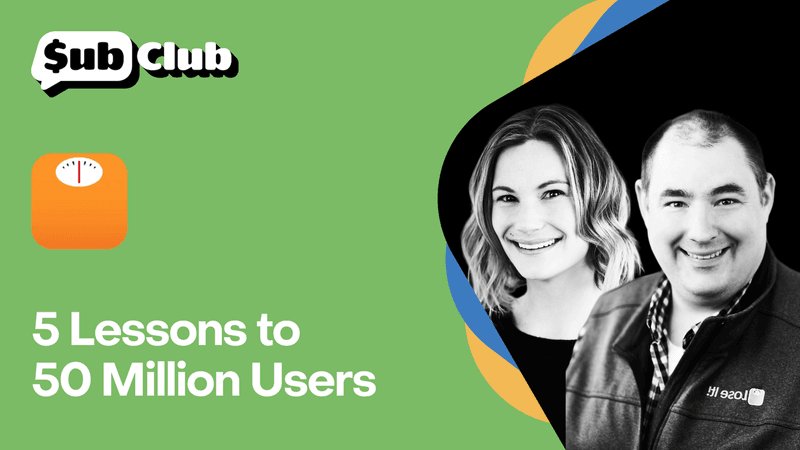50 million users, 5 key strategies: Lessons From Lose It!
And how to overcome the challenge of converting users when the free product is so good.

Getting to a million users is a challenge and a major accomplishment — let alone getting to 50 million.
But leadership at Lose It!, one of the original health and wellness apps and now a market leader, can offer more than a few strategies for getting at least some of the way there.
Lose It! Vice President (VP) of Marketing Erin Webster-Shaller and Senior VP of Operations Paul Apollo offer key insights into how organic growth has been the foundation of the app’s outsized success and how to achieve it.
5 ways to reach 50 million users (and turn them into subscribers)
Whether you’re just getting started, angling for modest growth, or looking to scale, how you grow matters just as much as the growth itself when looking at your app’s long-term sustainability.
With experience in building an app stretching all the way back to 2008, Lose It! is the ideal guide to healthy growth — here are some of the wins and tough lessons from its journey.
1. Excellent free products need a large user base to upsell
When a product works well for its users, it’s going to grow. The challenge comes from how you upsell — a challenge amplified for products with large free user bases. Top-quality offerings rely on these user bases for upsell opportunities.
“We want to make sure that there is an excellent free product available for anybody who wants access to it,” highlights Erin, whose role focuses on figuring out how to create and position premium features to free users.
They’ve mastered the tightrope walk between the mission of providing a quality free product and monetizing free users by convincing them to switch to premium — without diminishing a strong brand.
“Over the years, we’ve developed a framework for how we think about what’s free and what’s premium,” Erin explains. Every new feature is categorized accordingly, and then released. “That’s been our main way to justify [the] price [and] continue to upsell people. We try not to take free features and put them behind the paywall. But if we have to, we will.”
Identify the crowd-pleasers among your features. Then, message your user base about special offers and discounts — especially for price-sensitive audiences — to deliver big returns and drive premium subscription adoption.
2. Extend onboarding for increased trial engagement
A prolonged onboarding process — which Lose It! calls “longboarding” — that involves more personalized questions is proven to boost trial start rates in the health and wellness space. But the same can easily be applied to other markets.
What matters most is promising a tailored user experience — and experimenting non-stop along the way to find the sweet spot.
“Introducing loss aversion as a part of onboarding is an evolution of our longboarding strategy, which we’ve been engaged in since 2018,” Paul says. You might think that quick, painless, friction-free onboarding is the name of the game. But when the team at Lose It! saw that onboardings were getting inexplicably longer, they decided to run with the trend.
“Questions [were] being asked that there’s no way [were] being used as part of product setup,” Paul explains. Lose It! didn’t worry about what the answers to the questions were — only that onboarding was longer and, as a result, rates were going up by double digits. Lose It! kept going with the longboarding until returns diminished.
But adding premium features to onboarding doesn’t always increase conversion rates. Some even introduced pain points for users. “Onboarding is big and complex,” Paul says. “We do not touch it without running A/B tests.”
A longboarding strategy isn’t a silver bullet, but if users feel like the experience is customized for them, they’re more likely to commit, improving user retention.
3. Celebrate user success to drive word-of-mouth marketing
There’s nothing quite like celebration driving even more growth and success. “From day one, this app grew through word-of-mouth and organic acquisition,” Erin highlights. When users achieve something notable, applauding it encourages them to share their experiences — which, in turn, fuels organic promotion of your app. This process even strengthens the bond between your brand and users.
“When you find success…[and] people are noticing, now you’re going to scream from the rooftops, Look at what I’ve accomplished!” Erin explains. Targeting users who’ve hit important milestones has always been a core part of Lose It!’s marketing strategy. “When somebody is feeling really good about what they’ve accomplished, [it] helps us to drive that word-of-mouth flywheel,” she says.
Don’t stop experimenting with different referral methods: Lose It! toyed with Headspace’s sweepstakes idea as a potential incentivization route.
At the same time, keep in mind that referrals might not be scalable, and they might even backfire at times. “It’s really hard to know what’s incremental and how much are you paying for stuff you would have gotten anyway,” Paul explains. “People who were exposed to the treatment for this particular referral program had lower LTV than people who weren’t.”
In any case, organic seems to be the way to go: “Our paid marketing is a very, very small part of our overall marketing mix,” Erin says. Beyond organic channels, it’s all about growing the free user base by focusing on App Store Optimization (ASO), and then monetizing that base once they’re in the app.
4. Encourage set-up of premium features during trials
In tandem with longboarding, consider nudging users toward toying with premium features during their trial phase. The time spent setting up these features can increase the chances of users missing them post-trial.
“We’ve spent a long time…finding features that people can set up during onboarding because it really introduces this idea of loss aversion, especially after you’ve spent about 10 minutes taking a survey.”
But the team also pays attention to base users who haven’t converted after using the app for 30 days. They offer progressively steeper discounts and monetize cohorts that would otherwise remain untapped. The promise of building a freemium base is that users should convert over time. But if you’re reaching 30 days with no conversion and there’s a single-digit likelihood of them ever converting, these sorts of discounts just might convert.
“If they convert, it’ll be because they leave and come back — and we hit them as a reactivated user,” Paul says.
Always carefully A/B test premium features activated with a trial, as user resonance often varies. “There’s going to be a subset of folks that just don’t need premium,” Paul explains. “But there’s this group of folks who just want … whatever the best version of Lose It! is.”
5. Identify key actions to boost user conversion
Simple spreadsheet calculations and sophisticated machine learning models both point to the same strategy: You should use data analysis to identify actions that predict the likelihood of users subscribing.
Once you’ve identified users that are likely to subscribe, special offers and discounts can entice users to upgrade to premium subscriptions. “If you’re trying to predict a user who’s going to convert, you’re going to [think], Oh, it’s a user who actually uses the app,” Paul says. “But we have been able to identify some leverage points.” Incremental A/B testing resulted in a series of small, successive wins.
“We spend 80% of our time on new and reactivated users because if you’re going to get a 5% win, you’d rather do it on the users who are already 50% of your bookings,” Paul explains.
Lose It! also found in-app messaging to be more powerful and cheaper than push or email — with users who saw these offers worth much more than those who didn’t. “We were seeing that when we [did] exactly the same thing and change[d] the format, we [we]re making 10 times more money,” Paul says. While they still believe contextual promos are highly valuable, if users are in the right headspace (and in the app) when hit with an offer, they’re much more likely to upgrade.
It only takes one way to be right
If listening to subscription app developers and teams teaches use any one thing, it’s that there’s no single universal way to grow an app sustainably. But it only takes one right way to be successful.
It’s tempting to chalk up Lose It!’s success to when they entered the market — at the birth of the App Store in 2008. But the more important factor is that they’ve consistently applied the same strategy for 15 years, underpinned by the same mission: to provide a top-notch product for anyone who wants it. When you please your users, the sky’s the limit.
This blog post is based on an episode of the Sub Club Podcast.
You might also like
- Blog post
Modeling attribution on iOS: what works, what doesn’t, and how to choose
How to navigate the messy world of SKAN, AEM, and probabilistic attribution — plus two practical frameworks to get a clearer picture of campaign performance.
- Blog post
Your sprints must pay for themselves: Dan Layfield’s product advice
What’s worth building? Dan Layfield shares a 3-bucket framework to help app teams prioritize features, fix churn, and ship faster.
- Blog post
Is monetization hurting your app’s user experience?
Don’t trade short-term revenue for long-term trust. How ethical UX can still drive effective monetization.

